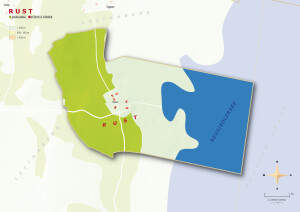The historic, botrytis-affected sweet white wines produced in and around the Austrian city of Rust now have their own PDO (protected designation of origin). Welcome to the world, Ruster Ausbruch DAC! (DAC = Districtus Austriae Controllatus, which translates roughly to controlled Austrian district for the production of wine.) This makes for a total of 16 DAC regions in Austria, with the Ruster Ausbruch DAC being the first (and only) such designation exclusively for sweet wines.
Ruster Ausbruch DAC may be produced using any of the white grapes approved for use in the region. It may be produced as a single-variety wine or as a blend. The most commonly used grapes include Weissburgunder (Pinot Blanc), Grauburgunder (Pinot Gris), Chardonnay (Morillon), Muskateller (Muscat), and Furmint.
The regulations for Ruster Ausbruch DAC include the following:
- Must be produced exclusively from grapes harvested in the Free City of Rust
- Must be entirely produced and bottled within the designated region
- May be produced using any combination of the Qualitätswein grape varieties permitted in the region (white grapes only); approved grapes include Pinot Blanc (Weissburgunder), Muscat (Muskateller), Pinot Gris (Grauburgunder), Furmint, Chardonnay, Neuburger, and Welschriesling
- Must comply with basic requirements for Trockenbeerenauslese grapes and wine
- Mandatory harvesting by hand; selectively-picked botrytis-affected berries
- Minimum must weight at harvest: 30° KMW
- Minimum residual sugar: 45 g/l
Welcome to the world, Ruster Ausbruch DAC!
Note: As with all such updates, this change will need to wind its way through EU approval; however, as the Austrian government has granted their approval, the changes can be implemented in the meantime. Most likely, the Ruster Ausbruch DAC will apply as of the release of the wines of the 2020 vintage. If the EU fails to approve the amendment, the regulation will be rescinded (although this seems unlikely to happen).
References/for more information:
- https://www.austrianwine.com/our-wine/wine-growing-regions/burgenland/rust
- DAC-Verordnung Ruster Ausbruch
- Map and photo via the Austrian Wine Marketing Board: https://www.austrianwine.com/press-multimedia/maps
Post authored by Jane A. Nickles…your blog administrator: jnickles@societyofwineeducators.org

